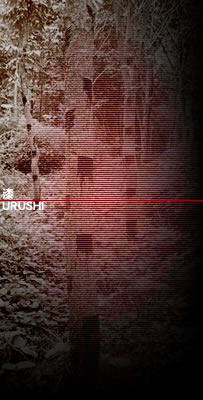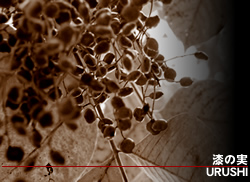
|
 |
In much of the literature on lacquerware, the regional sources of urushi, the lacquer sap of high-quality lacquerware, are recognized as China, India and mid-Asia. The eShiny-Leaf Cultural Zones' that characterize these regions provide a representative example, in the form of lacquer sap, of a plant-using culture. While the lacquer tree is a deciduous tree, the lacquer sap, like rice, can be seen as an agricultural product, with the areal extent of its use expanding
The Koregawa archeological ruins of Hachinohe City and the Kamegaoka ruins of western Tsugaru's Kizukuri Town, both located in Aomori Prefecture, have yielded lacquered earthenware from which it is possible to establish lacquer use in Japan from the early Jomon period. In addition, findings of lacquered basketware reveal the high level of lacquering technique that was used at the time, evidence that rather than lacquer being introduced from China and India, the extent of the Shiny Leaf Cultural Zone had expanded northward such that the Tohoku Region of Japan could claim its own lacquer culture.
Source: Tsugaru Lacquerware,
by Sato Takeji and Hashimoto Yoshihiro; 1987, July 31; page 23 |
The superior lacquer culture that existed in Aomori Prefecture during the Jomon period is seen in the variety of colored lacquerware artifacts discovered at the Koregawa archeological ruins of Hachinohe City, the Kamegaoka archeological ruins of Kizukuri Town and the Sannai Maruyama archeological ruins of Aomori City. However, such Jomon period lacquerware is not limited to Aomori Prefecture, but rather has been discovered in sites throughout Japan. In addition to Jomon sites, Yayoi burial mounds and other ancient sites have yielded artifacts with bases of wood, bark, fiber, hides, metal and paper, which were shaped and strengthened as well as decorated using lacquer sap, revealing both the practical and ornamental sides of lacquer use.
Such findings, together with artifacts such as the Shosoin-gyobutsu (objects used by the Emperor) and Tagajo-urushimonjo (lacquered parchments of the Taga castle) allow for the study of lacquer culture throughout Japan.
|
|
|
Given the lack of historical materials, it is impossible to say with certainty whether the Jomon period lacquer techniques of Aomori Prefecture present a starting point of a continuous connection to the known origins of present-day Tsugaru lacquerware. However, with the recent discoveries of wood bases and the variety of crafters activities, such supposition can only enlighten Tsugaru's lacquer culture.
Source: Appare! Tsugaru Nuri, by Sato Takeji; Hirosaki University Press, 2005, March 15; page 40 |
|
 |
|
|